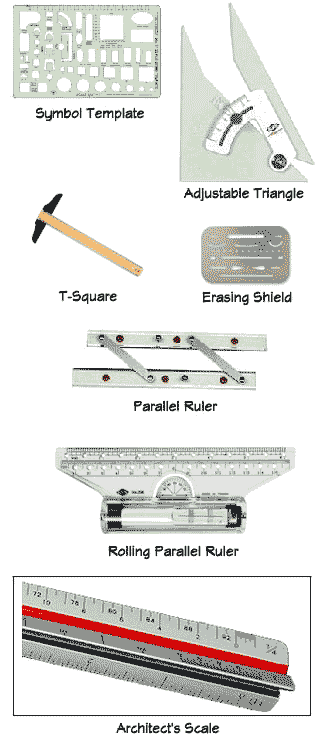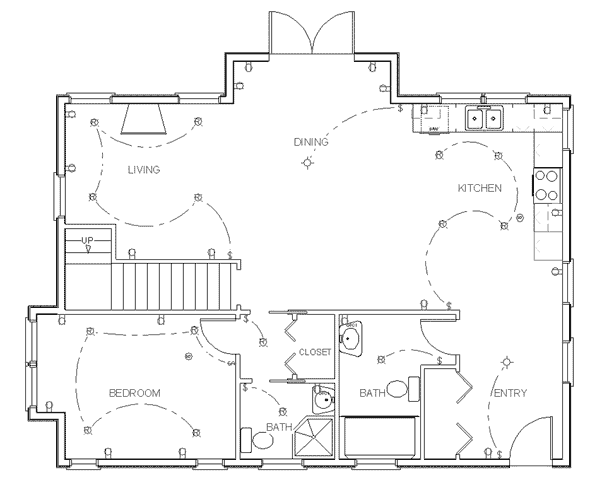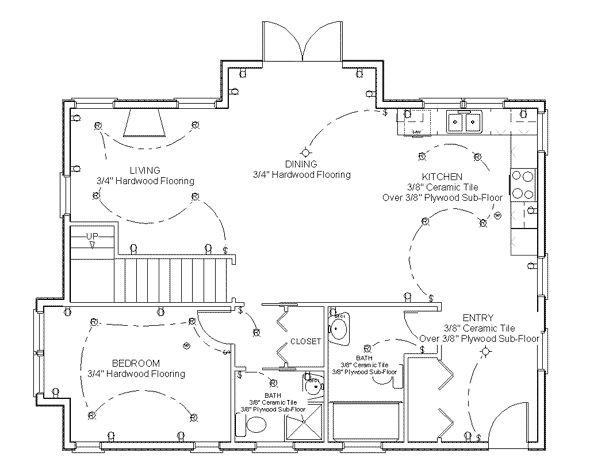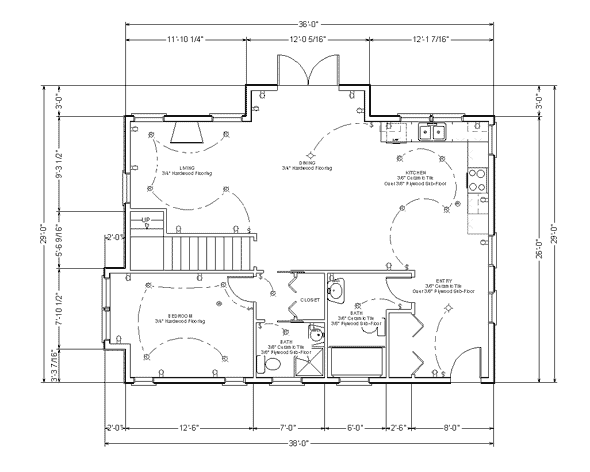Squared Paper for Drawing House Plans
Make Your Own Blueprint
How to Draw Flooring Plans by Hand or with Abode Design Software

This Make Your Own Blueprint tutorial will walk you through the detailed steps of how to draw floor plans for your new home blueprint. This process tin be followed past those drafting their blueprints by hand or using home design software.
For this tutorial, we are assuming that y'all have already completed your house design sketches. If you are merely starting out with your dwelling design, cheque out our free Home Blueprint Tutorial.
Folio Sections at a Glance
- Drafting Options
- Tools to Make Your Own Blueprints
- Using an Architect'south Scale
- The Blueprint Page Itself
- Draw Outside Walls
- Describe Interior Walls
- Locate Doors and Windows
- Draw Electrical Symbols
- Characterization Floor Surfaces
- Dimension Your Plans
- Add Article of furniture
- Create Window Schedule
Drafting Options
There are basically two ways to brand your own blueprints.
- Using habitation design software
- Drafting by hand
There is as well the option of doing a bit of both.
Some may enquire why would anyone make their own blueprints past paw when we have many relatively inexpensive abode design software products available.
Here are some good reasons:
- It takes a long time to truly learn how to use the firm pattern programs to completely generate the cross sections, framing and other design details that you need to get your edifice plans canonical.
- Most of the inexpensive programs (less than $250) do not generate the kind of details required for full construction drawings.
Most of the home blueprint programs can produce accurately dimensioned floor programme drawings of the quality required for your building permit. Merely for some programs this is as far every bit you lot can go with the structure drawings. What views remain are the cross-sections, elevation views, and any necessary framing plans. This is where you may have to brand your own blueprints by hand or use a more full-featured (and more expensive home pattern programme).
I am non suggesting to stay away from habitation design programs entirely. Rather a good approach if y'all want to keep costs downwardly is to exercise some drawing with blueprint software and some hand drafting.
The home design programs are great for allowing you to draw floor plans in 2nd so visualize them in 3D. You can hands movement walls as you refine your design. The pattern programs let you lot to quickly generate views of your ideas and designs. You lot can then easily modify the drawings equally y'all drag and drib furniture, appliances and fixtures into the blueprints. Oftentimes, you'll realize not enough infinite has been allowed for certain areas once the fixtures are in or perhaps you are wasting infinite in some areas.
Whether yous are using dwelling design software or drawing your blueprints by hand, the first drawings to get-go with are your floor plans. Using your own flooring plan sketches or your results from the Draw Floor Plan module of our house design tutorial, start by drawing the exterior walls of the main story of your home. (The sequence detailed below for drawing flooring plans by manus is a proficient one to follow if you are using design software likewise.)

Your local art supply store should accept all the of drawing tools you volition need to make your ain blueprints. You tin too order about of these supplies online. A good supplier is Utrecht Drafting Supplies.
- Architect'southward scale
- T-square
- Adjustable triangle
- Mechanical pencils with leads
- Felt tip pens
- Erasers
- Erasing shields (for accurate erasing of but specific parts of your drawing)
- Compass
- Symbol template
- Long metal ruler or straight edge
- Tracing paper
- Masking record
- Utility knife
- Large flat working surface (tabular array)
- White poster board as a base for your working surface
Optional but nice:
- Parallel ruler (for cartoon parallel lines — alternatively y'all can also use a T-square)
How to Use an Architect's Scale
To brand your own pattern to scale you will apply an architect's scale. Architect's scales are very simple to use, no math required.
For house plans, you should be using a scale of one/4 inch to a foot for the floor programme drawings. This is written as one/4":ane'. This means that every quarter inch you describe on your page represents 1 foot for the existent house as information technology will be built. So one inch on your drawing would stand for four feet of the congenital house.
Find the side of the triangular calibration which has 1/4":1' marked on it. The numbers on this side of the scale correspond feet for your built house. So if you needed to depict an exterior wall 36 anxiety long, y'all would:
- Lay the scale downwardly on the newspaper
- Make a pocket-size pencil marker on your paper by the zero marker on the scale
- Make another minor pencil mark on your newspaper by the 36 mark on the scale
- Utilize your metal straight edge to draw a directly line connecting the ii marks.
This line would measure ix inches on your drawing and would represent 36 anxiety for the built house.
When finished your drawings must have all room dimensions accurately marked. But edifice trades people volition often use an architect'southward scale (or ruler) while they are building to cheque various dimensions on your drawings. Then for this purpose brand certain that you employ you scale accurately for every line yous draw.
The Blueprint Folio Itself
To make your own blueprint floor plans, use a sheet of paper 24" by 36". Lay the sheet down on your working surface with the longest edge running horizontally.
The lower right hand corner of your drawing yous volition save for your title block. This is where y'all will write the name of the view you are drawing (floor plan, elevation, cross section), the scale of the drawing, the name of the house (could simply be the family name), designer'southward proper noun and engagement. The date is very important especially when you lot make changes to your plans. Everyone on the edifice site needs to know what appointment version of the plans they should exist using.
We ran into this issue when our concrete footings and mail service pads were being poured. Luckily I was watching the pour when I noticed the pads for the structural posts were beingness poured in the incorrect location. I talked with the coiffure and establish they had an old ready of drawings. We moved the forest framing for the pads and so hand shoveled the poured concrete over to the correct location.
Draw Exterior Walls
Start past drawing the outside walls of your design. You will desire to roughly middle your first floor plan view in the infinite on the paper available excluding the championship block. So before you draw your first wall, apply your scale get a crude idea of how much space on the page your commencement floor plan will need.
For this tutorial we will move in a clockwise direction starting at the upper left mitt corner of your drawing. You tin can choose how yous will orient the abode on the page. It is fairly standard to have the front door at the lower side of the horizontal sheet but depending on the blueprint or shape of your dwelling house y'all may want to change this.
For the floor plan drawings you lot will describe the framed walls, interior and outside. That is you volition not be drawing the finished dimensions of the rooms once drywall or other finished wall surfaces are installed. Other drawings volition detail finished surfaces of exterior and interior walls as required.
The structure drawings for the flooring plans need to be properly dimensioned for the framing crew. The room size difference with the drywall installed is very small and will just make about an inch of difference for any given room (a half inch of drywall on either side of the room). But there may be parts of your design where being out by an inch will cause problems (for instance if you are pre-ordering custom or stock cabinetry).


Start from the upper left hand corner of your floor programme pattern. At this signal practice not worry about doors and windows, nosotros will draw them in subsequently.
- Apply a pencil, your architect'due south scale and a straight edge to draw what the full inside dimension of the first wall will exist until it meets another wall (your exterior walls could be anywhere from several inches to a couple of feet thick—for a straw bale home for example).
- Use your T-square (or a protractor for a wall not at a foursquare bending to the previous wall) and architect's scale to depict the next wall.
- Keep in this fashion, clockwise around your drawing until the inside framing side of all of yous exterior walls are drawn.
- Finally, describe the outside of the exterior wall framing. If y'all are framing with 2 past 6s, your outside framed walls volition be v 1/2 inches thick (ii past 4s and 2 by 6s are run through a planer that takes a one-half inch off both their width and thickness).
Draw Interior Walls

For your interior walls:
- Depict both sides of each interior wall. If you will be using two by 4s to frame your interior walls, the actual thickness of each framed wall will be 3 1/2 inches (as explained to a higher place at the end of the drawing exterior walls section). Initially, just describe each wall, nosotros'll locate doors and any openings later.
- Draw walls around any stairwell areas. This helps visualize the stairwell expanse as a room. If in that location will not be a physical wall effectually the stairwell but describe a faint dotted line.
- Describe staircases and whatsoever mid-stair landings within these walls.
- Describe an arrow labeled "up" in the upwardly direction of the stair.
Draw Doors and Windows
The next step as you make your own blueprint is to describe your doors and windows onto the flooring plan. For each door, window or wall opening on your flooring plan:
- Utilize your calibration to locate its position.
- Draw the appropriate door or window symbol from the blueprints symbols glossary to properly identify it.

Characterization Rooms
In the center of each room, clearly characterization the room proper noun. Include closets and open spaces such equally entrances.

Locate Appliances, Plumbing and Fixtures
Using your scale, symbols template and direct border, draw the right symbols for:
- All appliances
- Built in furniture such as kitchen and bathroom cabinets and counters
- Plumbing items such as sinks, toilets and tubs
- Fireplaces
- Equipment such as furnaces, air conditioning units and water tanks.

Depict Electrical Symbols
All electrical symbols should now be added to your plans.
- Plug outlets
- Wall switches for lights or switchable plugs
- Wall light such as sconces
- Doorbells
Place the appropriate symbols along walls for the following electric items:
For ceiling mount items, draw the following fixtures on the floor but beneath the spot where the detail would be installed.
- Ceiling lights such as pot lights or track lighting.
- Fume alarms

Label Floor Surfaces
Detail the plans by indicating for each room how the floors volition be finished and any required sub-flooring. For instance your plans may read:
- 3/4" hardwood flooring
- 1/4" tile over i/ii" plywood sub-flooring
- Carpet over v/8" plywood sub-floor

Dimension Your Plans
The next step on your floor programme drawings is to draw accurate dimension lines. Yous will need to describe dimension lines for:
- Each room
- Closets
- Cabinet depths
- Distances from wall to back of toilet (know as the crude in dimension)
- Sizes of tubs
- Distances from walls to edge of any appliances or fixtures.
Note that non all required dimension lines are shown in the plan below—this is for ease of viewing. I more dimension line should run along each outside wall to locate all window and door openings.

Add Furniture
Furniture should non be included in your construction drawings merely for your ain design purposes it is a good idea to use scaled furniture cutouts during the design process to ensure you have designed adequate space for all rooms and apportionment paths. Run into our tutorial module Describe Floor Program for more information and furniture blueprint symbols.

Create Window and Door Schedule
The concluding pace to make your ain blueprint is to create a window and door schedule.
On your flooring plan:
- Label each door and window with a number or alphabetic character.
- In a blank expanse to the correct of the floor plan, create a iii column list.
- Put all the labels for your door and windows in the first column.
- List window and door types in the second column (casement, awning, fixed, single hung, etc.)
- List the verbal window size in the third column.
Adjacent Make Your Own Blueprint Module
Continue on to the next house construction drawing tutorial modules: How to Draw Elevations and Drawing Business firm Cross Sections.
No part of this web site may be reproduced or copied without written permission. Illegal Internet copies will be detected by Copyscape.

Source: https://www.the-house-plans-guide.com/make-your-own-blueprint.html
Belum ada Komentar untuk "Squared Paper for Drawing House Plans"
Posting Komentar